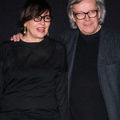FIT Museum to explore fashion trend sources of 250 years
A trend for Orientalism in fashion reached its zenith during the first decades of the 20th century. Typified in the designs of Paul Poiret, this interest in decorative arts and fashion, inspired by exports from Turkey, Japan, and China, lasted well into the 1920s. A suit by Poiret from 1912 will be on view.
Glamour was a significant fashion trend in the 1930s. With the onset of the Great Depression, moviegoers found escape in the glamour of Hollywood.
As a result, the shimmery bias-cut gowns worn on screen greatly influenced the fashions of the period, such as a floor-length, champagne–colored evening dress embellished with rhinestones, circa 1930, that will be featured in Trend-ology.
In the 1940s, a vogue developed in daywear for casual, brightly patterned cotton clothing designed for an active lifestyle. Pioneered by American designers Claire McCardell and Tom Brigance, this new aesthetic was dubbed “The American Look.” Examples of McCardell’s and Brigance’s work will be on view.
French couture came back full force after World War II with the trendy silhouette launched by Christian Dior’s New Look collection in 1947.
Well into the 1950s, New York-based designers such as Anne Fogarty continued to draw inspiration from Dior’s signature silhouette. To illustrate this transatlantic spread, a bright red Dior ensemble, circa 1950, will be shown alongside a circa 1954 Fogarty dress in a similar hue.
The rise of London youth culture in the 1960s served as a significant source of trends for the fashion industry as a whole.
This will be shown by a group of daringly short mini-dresses that illustrate the spread of the look from Mary Quant’s London boutique to the ready-to-wear collections of Geoffrey Beene in New York.
During this same time period, commercial air travel was becoming increasingly accessible, enabling socialites, fashion photographers, and designers alike to visit far-off locations more easily than ever before. As a result, exoticism reemerged.
The brightly colored Kaftans from Emilio Pucci and Oscar de la Renta that will be on view in Trend-ology became wardrobe essentials among the jetset.
While music has always had a large influence on fashion, this was especially true during the 1970s, when disco-fueled nightclubs, music festivals, and the underground punk scene served as ideal environments to foster fashion trends.
Halston’s slinky, silk jersey designs were perfect for moving across the dance floor at Studio 54. A particularly body-revealing jumpsuit, worn by Ethel Scull, a patron of pop and minimal art, will also be on display.
In the 1980s, conspicuous luxury became a key trend. Fashion consumers of the Reagan era cultivated a penchant for opulent embellishment, ornate textiles, and a saturated color-palette.
































-Ltd..jpg?tr=w-120,h-60,c-at_max,cm-pad_resize,bg-ffffff)





.jpg?tr=w-120,h-60,c-at_max,cm-pad_resize,bg-ffffff)
.jpg?tr=w-120,h-60,c-at_max,cm-pad_resize,bg-ffffff)






